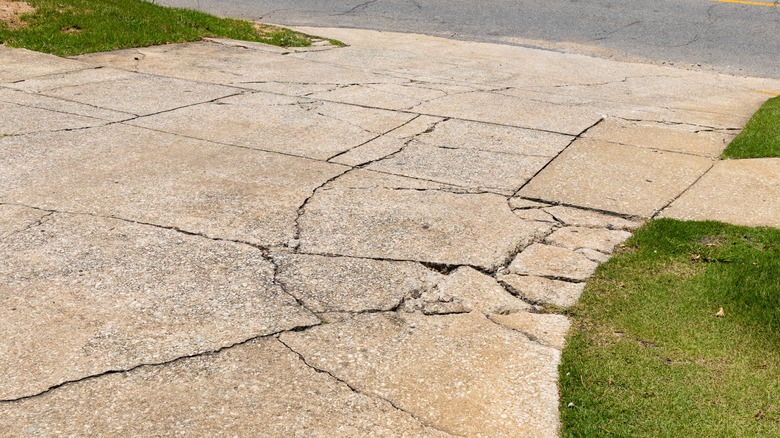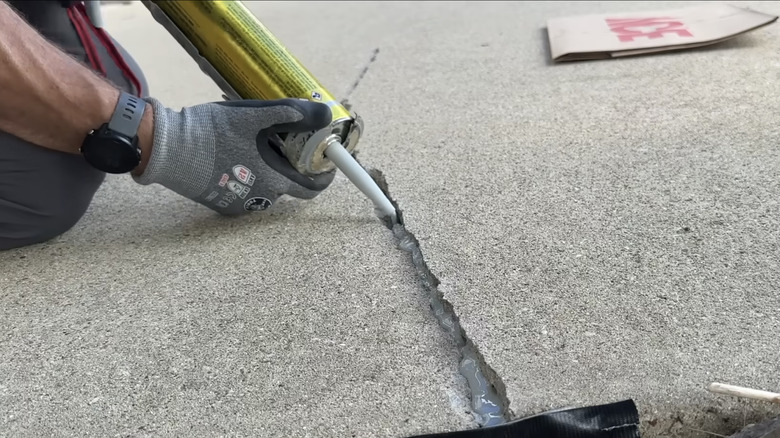Say Goodbye To Cracks In Your Driveway With One Simple Solution
It might not look like it, but your driveway is in constant motion. Whether tree roots, overweight cars, or ground shifts, your driveway's concrete is always shifting and moving, often resulting in pesky (and sometimes dangerous) cracks. Repairing those cracks ASAP is critical to the longevity of your driveway (and key to avoiding expensive repairs). The easiest method to say goodbye to cracks in your driveway? Using concrete caulk.
While concrete driveways are made to last, that durability comes with one major drawback: inflexibility. That inflexibility is great for creating an even driving surface, but it's also susceptible to cracking when its surroundings (a.k.a., the ground underneath it) change. To successfully patch these cracks, you need something that is as flexible as concrete is inflexible. That's where concrete caulk comes in. This affordable tool that can fill driveway cracks is the perfect solution because it not only sticks to the concrete, but it is pliable enough to shift with your driveway where other, more rigid patching options would crack. Let's explore which concrete caulk is right for your driveway, how to apply it to repair smaller fractures, and what to do if your driveway has huge cracks in it.
Find the right concrete caulk formula to seal driveway cracks
There are a lot of concrete repair products out there and many of them offer to "seal," "fix," or "patch" cracks in your concrete. And, to make it more complicated, many of the caulk tubes on the shelves are labeled "sealant." How do you know which one is right for your driveway repair project?
First, it's worth mentioning that while their names are often mixed up, concrete sealant and concrete caulk are two different products. Sealant is a fluid you pour over the concrete for protection and durability, similar to a topcoat. Concrete caulk, packaged in the traditional oblong tubes with a pointed applicator, can close or "seal" cracks. For this DIY, you need concrete caulk, specifically polyurethane concrete caulk. This formula bonds to concrete without any primer, withstands temperature fluctuations, and creates a clean, professional look.
When picking up your polyurethane concrete caulk, you may notice there are two options: self-leveling and no-sag. Experts are divided on which option is best. Some state that self-leveling is simpler to apply and looks cleaner while others promise that no-sag is ideal for beginners. One factor to keep in mind is that self-leveling caulk doesn't need to be smoothed out post-application for a finished look while no-sag does. If you'd rather apply and go, self-leveling may be right for you.
A step-by-step guide to fill cracks in your driveway
It's tempting to grab your caulk gun and run out to fill up the cracks, but trust us: Prepping the cracks will ensure your repairs will last. First, clean the cracks. Use an old flathead screwdriver or a putty knife to scrape loose dirt or concrete out, then run a wire brush or a power drill with a brush attachment over the edges for a thorough clean. Then, use a pressure washer to wash the crack clean as well as the whole driveway. Let it dry overnight.
The next day, check to see if the concrete has dried. If so, measure the crack's width and depth. If it's wider than a half centimeter or deeper than half an inch, grab a closed-cell polyethylene foam backer rod about 25% bigger than the crack to give the caulk support. Use your screwdriver or putty knife to insert it into the crack. If the cracks extend to the edges of the driveway, tape the edges to keep the caulk from spilling out. Cut the caulk nozzle at a 45-degree angle and apply. Work fast, using even pressure and keeping the caulk tip in the crack to fill it completely. If using non-sag caulk, run a damp finger over the caulk line to smooth it out. Let it cure according to the instructions. For a cohesive look, scatter sand on the caulk 10 minutes after application.
If you have large driveway cracks, you can use this method. Use a bigger backer rod and use as many applications of caulk as needed. However, consider speaking to a professional about paving a new driveway.


